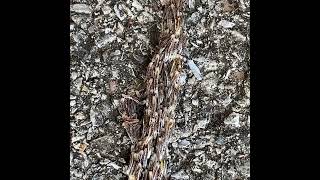Have you ever seen a pulsating, snake-like mass slithering across the ground? It might sound like something out of a horror movie, but it’s actually a fascinating phenomenon in the insect world!
Yesterday, I captured a video of just that at the Wichita Mountains National Wildlife Refuge in Oklahoma. It turned out to be a parade of fungus gnat larvae! On Facebook, someone asked a fantastic question: why do they bunch up like that?
Intrigued, I dug into the science behind this amazing behavior. Here’s what I discovered:
Strength in Numbers: Protecting Against Predators
There’s safety in numbers, and these gnat larvae know it! By forming a large group, they become less appealing to hungry predators like birds and insects. Imagine a bird trying to pick off one larva from a wriggling mass – it’s much harder than snatching a lone straggler.
Keeping It Moist: The Mucus Advantage
Fungus gnat larvae are tiny and vulnerable to drying out. But when they travel together, they secrete a special mucus that helps them glide smoothly over each other. This slimy layer helps them retain moisture, which is essential for their survival.
Finding New Homes: The Great Gnat Migration
This mass movement, also known as a “sciarid snake,” is thought to be a way for the larvae to explore and find new resources. By traveling together, they can venture further distances safely, searching for fresh food sources or ideal pupation sites – the place where they transform into adult gnats.
Ready for Takeoff: The Final Act
Interestingly, these processions often happen when the larvae are nearing the end of their growth stage before becoming pupae. They might be on the hunt for the perfect spot to pupate, away from the hustle and bustle of their current location.
The Mystery Continues: A Fascinating Adaptation
While the exact reason why they trigger this behavior is still a bit of a mystery, it’s clear that moving together is a powerful adaptation for these tiny creatures. It’s a testament to the power of collective action – even in the world of fungus gnats!
So next time you see a strange, wriggling mass on the ground, take a closer look! It might just be a parade of fungus gnat larvae, on their way to a safer, moister future.


Great report, thanks for teaching us so much! We are not writing but we are thankful!
Fascinating! Your video was an added bonus. Very interesting how the mass of larvae split around the large pebble, and then, when the bulk of the creatures didn’t follow the branching lead, the branch withered as the individuals turned back to rejoin the main group.